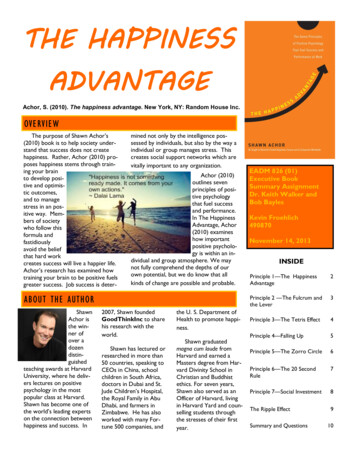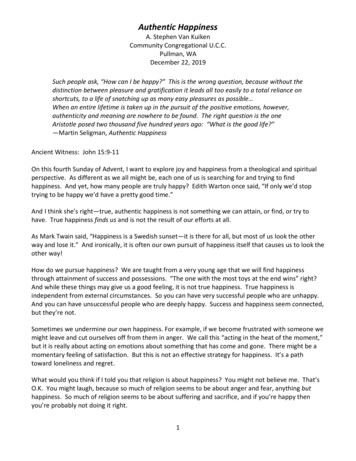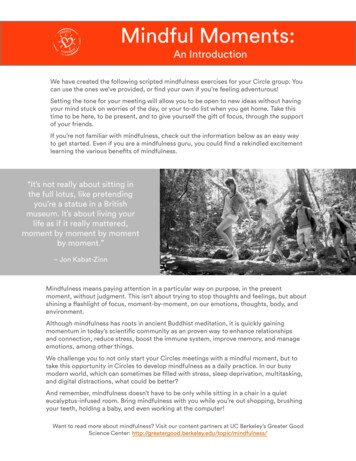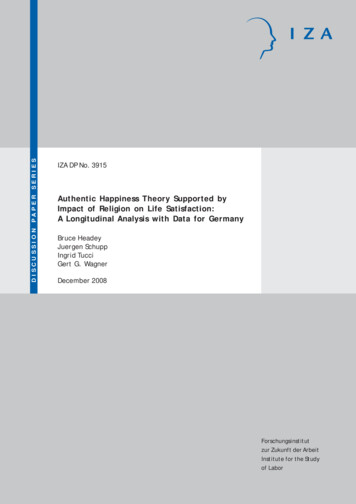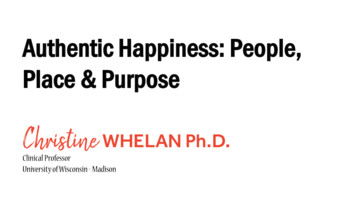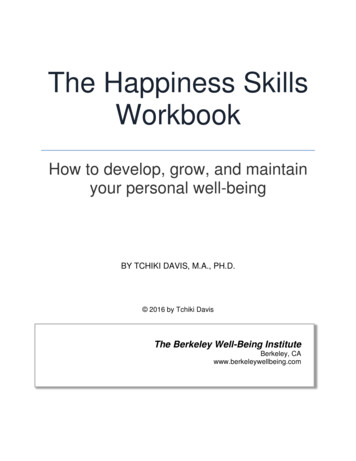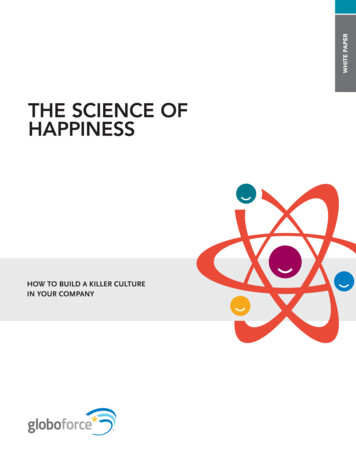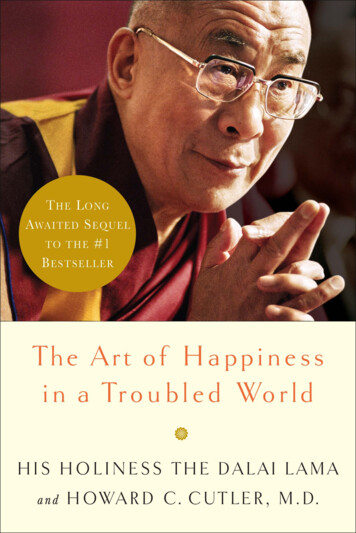
Transcription
The Art of Happinessin a Troubled WorldtHis Holinessthe Dalai LamaandHoward C. Cutler, MDDoubledayNew YorkCutl 9780767920643 3p fm r1.e.indd iiiLondonTorontoSydneyAuckland8/21/09 11:07:18 AM
Copyright 2009 by His Holiness the Dalai Lama and Howard Cutler, M.D.All rights reserved.Published in the United States by Doubleday Religion,an imprint of the Crown Publishing Group,a division of Random House, Inc., New York.www.crownpublishing.comdoubleday and the dd colophon areregistered trademarks of Random House, Inc.Library of Congress Cataloging-in-Publication DataBstan-’dzin-rgya-mtsho, Dalai Lama XIV, 1935–The art of happiness in a troubled world / the Dalai Lama and Howard Cutler.p. cm.1. Happiness—Religious aspects—Buddhism. 2. Conduct of life. 3. Religiouslife—Buddhism. I. Cutler, Howard C. II. Title.BQ7935.B774A82 2009294.3'444—dc222009024717ISBN 978-0-767-92064-3Printed in the United States of AmericaDesign by Elizabeth Rendfleisch13579108642First Editionwww.DoubledayReligion.comCutl 9780767920643 3p fm r1.e.indd iv8/21/09 11:07:19 AM
To purchase a copy ofThe Art of Happiness in aTroubled Worldvisit one of these online retailers:AmazonBarnes & NobleBordersIndieBoundPowell’s BooksRandom Housewww.DoubledayReligion.com
tCONTENTSAUTHOR’S NOTEINTRODUCTIONPA RT O NEviiixI, Us, and Them1Chapter 1Me Versus We 3Chapter 2Me and WeChapter 3Prejudice (Us Versus Them)Chapter 4Overcoming PrejudiceChapter 5Extreme Nationalism 97254567www.DoubledayReligion.comCutl 9780767920643 3p fm r1.e.indd v8/21/09 11:07:19 AM
PA RT T WOPA RT T H R E EViolence Versus Dialogue109Chapter 6Human Nature Revisited 111Chapter 7Violence: The CausesChapter 8The Roots of ViolenceChapter 9Dealing with Fear 156126137Happiness in a Troubled World181Chapter 10 Coping with a Troubled World183Chapter 11Hope, Optimism, and ResilienceChapter 12Inner Happiness, Outer Happiness,203and Trust 245Chapter 13Positive Emotions and Buildinga New World264Chapter 14 Finding Our Common HumanityChapter 15278Empathy, Compassion, and FindingHappiness in Our Troubled WorldABOUT THE AUTHORS303337www.DoubledayReligion.comCutl 9780767920643 3p fm r1.e.indd vi8/21/09 11:07:20 AM
tC h a p t e r1ME VERSUS WEI think this is the first time I am meeting most of you. But whether it is anold friend or a new friend, there’s not much difference anyway, because Ialways believe we are the same: We are all just human beings. —h.h. thedalai lama, speaking to a crowd of many thousandsTIME PASSES. The world changes. But there is one constant I havegrown used to over the years, while intermittently traveling onspeaking tours with the Dalai Lama: When speaking to a general audience, he invariably opens his address, “We are all the same . . .”Once establishing a bond with each member of the audience in thatway, he then proceeds to that evening’s particular topic. But over theyears I’ve witnessed a remarkable phenomenon: Whether he is speakingto a small formal meeting of leaders on Capitol Hill, addressing a gathering of a hundred thousand in Central Park, an interfaith dialogue inAustralia, or a scientific conference in Switzerland, or teaching twentythousand monks in India, one can sense an almost palpable effect. Hewww.DoubledayReligion.comCutl 9780767920643 3p 01 r1.e.indd 38/21/09 11:08:52 AM
4I, US, AND THEMseems to create a feeling among his audience not only of connection tohim, but of connection to one another, a fundamental human bond.It was early on a Monday morning and I was back in Dharamsala,scheduled to meet shortly with the Dalai Lama for our first meetingin a fresh series of discussions. Home to a thriving Tibetan community, Dharamsala is a tranquil village built into a ridge of the Dauladarmountain range, the foothills of the Himalayas in northern India. I hadarrived a few days earlier, around the same time as the Dalai Lamahimself, who had just returned home from a three-week speaking tourin the United States.I finished breakfast early, and as the Dalai Lama’s residence wasonly a five-minute walk along a mountain path from the guesthousewhere I was staying, I retired to the common room to finish my coffeeand review my notes in preparation for our meeting. Though the roomwas deserted, someone had left on the TV tuned to the world news. Absorbed in my notes, I wasn’t paying much attention to the news and forseveral minutes the suffering of the world was nothing but backgroundnoise.It wasn’t long, however, before I happened to look up and a storycaught my attention. A Palestinian suicide bomber had detonated anexplosive at a Tel Aviv disco, deliberately targeting Israeli boys and girls.Almost two dozen teenagers were killed. But killing alone apparentlywas not satisfying enough for the terrorist. He had filled his bomb withrusty nails and screws for good measure, in order to maim and disfigure those whom he couldn’t kill.Before the immense cruelty of such an act could fully sink in, othernews reports quickly followed—a bleak mix of natural disasters and intentional acts of violence . . . the Crown Prince of Nepal slaughters his entire family . . . survivors of the Gujarat earthquake still struggle to recover.Fresh from accompanying the Dalai Lama on his recent tour, Ifound that his words “We are all the same” rang in my head as I watchedthese horrifying stories of sudden suffering and misery. I then realizedI had been listening to these reports as if the victims were vague, faceless abstract entities, not a group of individuals “the same as me.” Itseemed that the greater the sense of distance between me and the vicwww.DoubledayReligion.comCutl 9780767920643 3p 01 r1.e.indd 48/21/09 11:08:52 AM
5ME VERSUS WEtim, the less real they seemed to be, the less like living, breathing human beings. But now, for a moment, I tried to imagine what it wouldbe like to be one of the earthquake victims, going about my usual dailychores one moment and seventy-five seconds later having no family,home, or possessions, suddenly becoming penniless and alone.“We are all the same.” It was a powerful principle, and one that I wasconvinced could change the world.t“Your Holiness,” I began, “I’d like to talk with you this morning aboutthis idea that we are all the same. You know, in today’s world there issuch a pervasive feeling of isolation and alienation among people, afeeling of separateness, even suspicion. It seems to me that if we couldsomehow cultivate this sense of connection to others, a real sense ofconnection on a deep level, a common bond, I think it could completely transform society. It could eliminate so many of the problemsfacing the world today. So this morning I’d like to talk about this principle that we are all the same, and—”“We are all the same?” the Dalai Lama repeated.“Yes, and—”“Where did you get this idea?” he asked.“Huh?”“Who gave you this idea?”“You . . . you did,” I stammered, a bit confused.“Howard,” he said bluntly, “we are not all the same. We’re different!Everybody is different.”“Yes, of course,” I quickly amended myself, “we all have these superficial differences, but what I mean is—”“Our differences are not necessarily superficial,” he persisted. “Forexample, there is one senior Lama I know who is from Ladakh. Now,I am very close to this Lama, but at the same time, I know that heis a Ladakhee. No matter how close I may feel toward this person,it’s never going to make him Tibetan. The fact remains that he is aLadakhee.”www.DoubledayReligion.comCutl 9780767920643 3p 01 r1.e.indd 58/21/09 11:08:53 AM
6I, US, AND THEMI had heard the Dalai Lama open his public addresses with “We areall the same” so often over the years that this turn of conversation wasstarting to stagger me.“Well, on your tours over the years, whenever you speak to big audiences, and even on this most recent, you always say, ‘We are all thesame.’ That seems like a really strong theme in your public talks. Forexample, you say how people tend to focus on our differences, but weare all the same in terms of our desire to be happy and avoid suffering,and—”“Oh yes. Yes,” he acknowledged. “And also we have the same human potential. Yes, I generally begin my talk with these things. This isbecause many different people come to see me. Now I am a Buddhistmonk. I am Tibetan. Maybe others’ backgrounds are different. So if wehad no common basis, if we had no characteristics that we share, thenthere is no point in my talk, no point in sharing my views. But the factis that we are all human beings. That is the very basis upon which I’msharing my personal experience with them.”“That is the kind of idea I was getting at—this idea that we are allhuman beings,” I explained, relieved that we were finally on the samepage. “I think if people really had a genuine feeling inside, that all human beings were the same and they were the same as other people, itwould completely transform society . . . I mean in a genuine way. So,I’m hoping we can explore this issue a little bit.”The Dalai Lama responded, “Then to really try to understand this,we need to investigate how we come to think of ourselves as independent, isolated or separate, and how we view others as different or separate, and see if we can come to a deeper understanding. But we cannotstart from the standpoint of saying simply we are all the same and denying that there are differences.”“Well, that is kind of my point. I think we can agree that if peoplerelated to each other as fellow human beings, if everyone related toother people like you do, on that basic human level, like brothers andsisters, as I’ve heard you refer to people, the world would be a far betterplace. We wouldn’t have all these problems that I want to talk to youwww.DoubledayReligion.comCutl 9780767920643 3p 01 r1.e.indd 68/21/09 11:08:53 AM
7ME VERSUS WEabout later, and you and I could talk about football games or moviesinstead!“So, I don’t know,” I continued, “but it seems that your approach tobuilding the sense of connection between people is to remind them ofthe characteristics they share as human beings. The way you do whenever you have the opportunity to speak to a large audience.”“Yes.” He nodded.“I don’t know . . .” I repeated again. “It is such an important topic,so simple an idea yet so difficult in reality, that I’m just wondering ifthere are any other methods of facilitating that process, like speedingit up, or motivating people to view things from that perspective, giventhe many problems in the world today.”“Other methods . . .” he said slowly, taking a moment to carefullyconsider the question while I eagerly anticipated his insights and wisdom. Suddenly he started to laugh. As if he had a sudden epiphany, heexclaimed, “Yes! Now if we could get beings from Mars to come downto the earth, and pose some kind of threat, then I think you would seeall the people on Earth unite very quickly! They would join together,and say, ‘We, the people of the earth!’ ” He continued laughing.Unable to resist his merry laugh, I also began to laugh. “Yes, I guessthat would about do it,” I agreed. “And I’ll see what I can do to speak tothe Interplanetary Council about it. But in the meantime, while we’reall waiting for the Mothership to arrive, any other suggestions?”tThus we began a series of conversations that would continue intermittently for several years. The discussion began that morning with mycasually tossing around the phrase “We are all the same” as if I wascoming up with a slogan for a soft drink ad that was going to unitethe world. The Dalai Lama responded with his characteristic refusal toreduce important questions to simplistic formulas. These were criticalhuman questions: How can we establish a deep feeling of connectionto others, a genuine human bond, including those who may be verywww.DoubledayReligion.comCutl 9780767920643 3p 01 r1.e.indd 78/21/09 11:08:53 AM
8I, US, AND THEMdifferent? Is it possible to even view your enemy as a person essentiallylike yourself? Is it possible to really see all human beings as one’s brothers and sisters, or is this a utopian dream?Our discussions soon broadened to address other fundamental issues dealing with the relationship between the individual and society.Serious questions were at stake: Is it possible to be truly happy whensocial problems invariably impact our personal happiness? In seeking happiness do we choose the path of inner development or socialchange?As our discussions progressed, the Dalai Lama addressed thesequestions not as abstract concepts or philosophical speculation butas realities within the context of our everyday lives, quickly revealinghow these questions are directly related to very real problems and concerns.In these first discussions in Dharamsala, we dealt with the challengeof how to shift one’s orientation from Me to We. Less than a year later,I returned to Dharamsala for our second series of conversations—September 11 had occurred in the interim, initiating the worldwideWar on Terror. It was clear that cultivating a We orientation was notenough. Acutely reminded that where there is a “we” there is also a“they,” we now had to face the potential problems raised by an “usagainst them” mind-set: prejudice, suspicion, indifference, racism,conflict, violence, cruelty, and a wide spectrum of ugly and terribleattitudes with which human beings can treat one another.When we met in Tucson, Arizona, several years later, the DalaiLama began to weave together the ideas from our many conversationson these topics, presenting a coherent approach to coping with ourtroubled world, explaining how to maintain a feeling of hope and evenhappiness despite the many problems of today’s world.But that Monday morning we began on the most fundamental level,exploring our customary notions about who we are and how we relateto the world around us, beginning with how we relate to those in ourown communities and the role that plays in our personal and societalhappiness.www.DoubledayReligion.comCutl 9780767920643 3p 01 r1.e.indd 88/21/09 11:08:53 AM
9ME VERSUS WE“No Sense of Community, No Anchor”On a recent Friday afternoon, an unemployed twenty-year-oldposted a message on YouTube, simply offering to “be there” for anyone who needed to talk. “I never met you, but I do care,” he said.By the end of the weekend, he had received more than fivethousand calls and text messages from strangers taking him upon his offer.Continuing our discussion, I reviewed. “You know, Your Holiness, ourdiscussions over the years have revolved around the theme of humanhappiness. In the past we discussed happiness from the individualstandpoint, from the standpoint of inner development. But now we aretalking about human happiness at the level of society, exploring some ofthe societal factors that may affect human happiness. I know of coursethat you have had the opportunity to travel around the world manytimes, visiting many different countries, so many different cultures, aswell as meeting with many different kinds of people and experts in somany fields.”“Yes.”“So, I was just wondering—in the course of your travels, is thereany particular aspect of modern society that you have noticed that youfeel acts as a major obstruction to the full expression of human happiness? Of course, there are many specific problems in today’s world,like violence, racism, terrorism, the gap between rich and poor, theenvironment, and so on. But here I’m wondering if there is more of ageneral feature of society that stands out in your mind as particularlysignificant?”Seated upon a wide upholstered chair, the Dalai Lama bent downto unlace his plain brown shoes while he silently reflected on thequestion. Then, tucking his feet under him in a cross-legged position,settling in for a deeper discussion, he replied, “Yes. I was just thinkingthere is one thing I have noticed, something that is very important. Iwww.DoubledayReligion.comCutl 9780767920643 3p 01 r1.e.indd 98/21/09 11:08:53 AM
10I, US, AND THEMthink it could be best characterized as a lack of sense of community.Tibetans are always shocked to hear of situations where people are living in close proximity, have neighbors, and they may have been yourneighbors for months or even years, but you have hardly any contactwith them! So you might simply greet them when you meet, but otherwise you don’t know them. There is no real connection. There is nosense of community. These situations we always find very surprising,because in the traditional Tibetan society, the sense of community isvery strong.”The Dalai Lama’s comment hit home with me—literally and figuratively. I thought, not without some embarrassment, that I myself didn’tknow the names of my neighbors. Nor had I known my neighbors’names for many years.Of course, I was not about to admit that now. “Yes,” I said, “youwill certainly see those kinds of situations.”The Dalai Lama went on to explain, “In today’s world you willsometimes find these communities or societies where there is no spiritof cooperation, no feeling of connection. Then you’ll see widespreadloneliness set in. I feel that a sense of community is so important. Imean even if you are very rich, if you don’t have human companionsor friends to share your love with, sometimes you end up simply sharing it with a pet, an animal, which is better than nothing. However,even if you are in a poor community, the poor will have each other. Sothere is a real sense that you have a kind of an anchor, an emotionalanchor. Whereas, if this sense of community is lacking, then whenyou feel lonely, and when you have pain, there is no one to really shareit with. I think this kind of loneliness is probably a major problemin today’s world, and can certainly affect an individual’s day-to-dayhappiness.“Now when we speak of loneliness,” he added, “I think we shouldbe careful of what we mean. Here I don’t necessarily mean lonelinessonly as the feeling of missing someone, or wanting a friend to talk to,or something like that. Because you can have a family who has a closebond, so they may not have a high level of individual loneliness, butthey may feel alienated from the wider society. So here I was speakingwww.DoubledayReligion.comCutl 9780767920643 3p 01 r1.e.indd 108/21/09 11:08:53 AM
11ME VERSUS WEof loneliness more as a wider kind of isolation or sense of separationbetween people or groups.”The decline of our sense of community has increasingly becomethe subject of popular discourse during the last decade, due in part tobooks such as Bowling Alone, by Robert D. Putnam, a political scientist at Harvard University. Putnam argues that our sense of community and civic engagement has dramatically deteriorated over the lastthirty years—noting with dismay the marked decline of neighborhoodfriendships, dinner parties, group discussions, club memberships,church committees, political participation, and essentially all the involvements that make a democracy work.According to sociologists Miller McPherson and Matthew E. Brashears from the University of Arizona and Lynn Smith-Lovin fromDuke University, in the past two decades the number of people who report they have no one with whom they can talk about important mattershas nearly tripled. Based on extensive data collected in the Universityof Chicago’s General Social Survey, the percentage of individuals withno close friends or confidants is a staggering 25 percent of the American population. This number is so surprising that it left the researchersthemselves wondering if this could really be an accurate estimate. Thesame organization conducted a similar nationwide survey back in 1985,shocking Americans then by revealing that, on average, people in oursociety had only three close friends. By 2005, this figure had droppedby a third—most people had only two close friends or confidants.The investigators not only found that people had fewer social connections over the past two decades but also discovered that the patternof our social connections was also changing. More and more peoplewere relying on family members as their primary source of social connection. The researchers, noting that people were relying less on friendships in the wider community, concluded, “The types of bridging tiesthat connect us to community and neighborhood have withered.”While the study did not identify the reasons for this decline in social connectedness and community, other investigators have identifieda number of factors contributing to this alarming trend. Historically,advances in modern transportation created an increasingly mobilewww.DoubledayReligion.comCutl 9780767920643 3p 01 r1.e.indd 118/21/09 11:08:53 AM
12I, US, AND THEMsociety, as more and more families pulled up roots and moved to newcities in search of better jobs or living conditions. As society becamemore prosperous, it also became a common practice among larger segments of the population for children to leave home to attend universities in other cities or states. Easier travel and communication haveallowed young people to move farther from the parental home thanever before, in search of better career opportunities.More recent studies show that working hours and commutes areboth longer, resulting in less time for people to interact with their community. These changes in work hours and the geographical scatteringof families may foster a broader, shallower network of ties, rather thanthe close bonds necessary for fulfillment of our human need for connection.Solitary TV viewing and computer use, ever on the rise, also contribute to social isolation. The growth of the Internet as a communication tool may play a role as well. While the Internet can keep usconnected to friends, family, and neighbors, it also may diminish theneed for us to actually see each other to make those closer connections.Researchers point out that while communication through tools suchas the Internet or text messaging does create bonds between people,these types of connections create weaker social ties than communication in person. Words are sometimes poor vehicles for expressing andcommunicating emotions; a great deal of human communication isconveyed through subtle visual cues that can be better perceived inface-to-face encounters.Whatever the cause, it is clear that the decline in our sense of community and the increasing social isolation have far-reaching implications on every level—personal, communal, societal, and global. Withhis characteristic wisdom and insight, the Dalai Lama is quick to pointout the importance of this issue, and its impact on human happinessboth on the individual level as well as on a wider societal level. Herethe views of both the Dalai Lama and Western science converge. Infact, echoing the Dalai Lama’s view, and summarizing the latest scientific research from many disciplines, Robin Dunbar, professor of psychology at the University of Liverpool in the UK, asserts, “The lack ofwww.DoubledayReligion.comCutl 9780767920643 3p 01 r1.e.indd 128/21/09 11:08:53 AM
13ME VERSUS WEsocial contact, the lack of sense of community, may be the most pressingsocial problem of the new millennium.”Building the Spirit of Community: The First Steps“Well, the medication is finally working!” said David, a well-groomed,nicely dressed young man sitting in my Phoenix office. “My depression has completely lifted, and I’m back to my normal state of unhappiness.” He was half joking—but only half. A bright, successful, singlethirty-two-year-old structural engineer, David had presented to treatment about a month earlier with a familiar spectrum of symptoms: sudden loss of interest in his usual activities, fatigue, insomnia, weight loss,difficulty concentrating—in short, a pretty ordinary, garden-varietydepression. It didn’t take long to discover that he had recently movedto Phoenix to accept a new job and the stresses related to the changehad triggered his depression.This was years ago, when I was in practice as a psychiatrist. I began him on a standard course of antidepressant medication, and hisacute symptoms of severe depression resolved within a few weeks.Soon after resuming his normal routine, however, he reported a morelong-standing problem, a many-year history of “a kind of mild chronicunhappiness,” an inexplicable pervasive sense of “dissatisfaction withlife,” and general lack of enthusiasm or “zest” for life. Hoping to discover the source and rid himself of this ongoing state, he asked to continue with psychotherapy. I was happy to oblige. So, after diagnosinghim with the mood disorder dysthymia, we set about in earnest, exploring the usual “family of origin” issues—his childhood, his overlycontrolling mother, his emotionally distant father—along with pastrelationship patterns and present interpersonal dynamics. Pretty standard stuff.Week after week, David showed up regularly, until terminatingtherapy a few months later, due to another job-related move. Over themonths his major depression had never returned, but we had madelittle to no headway with his chronic state of dissatisfaction.www.DoubledayReligion.comCutl 9780767920643 3p 01 r1.e.indd 138/21/09 11:08:53 AM
14I, US, AND THEMRemembering this patient now, who was by no means unique, Irecall one aspect of his personal history that seemed rather unremarkable at the time. His daily routine consisted of going to work five or sixdays a week, at least eight-hour days, then returning home. That aboutsummed it up. At home, evenings and weekends, he would generallywatch TV, play video games, maybe read a bit. Sometimes he wouldgo to a bar or to a movie with a friend, generally someone from work.There was the occasional date, but mostly he remained at home. Thisdaily routine had remained essentially unchanged for many years.Looking back on my treatment of David, I can only wonder onething: What in the world was I thinking?! For months I had been treating him for his complaints of a sense of dissatisfaction (“I dunno,there’s just something missing from my life. . . .”), exploring his childhood history, looking for patterns in past relationships, yet right infront of us his life had at least one significant gap, a gap that we failedto recognize. Not a small, obscure, or subtle gap, but rather a hugegaping cavern—he was a man with no community, no wider sense ofconnection.During my years of psychiatric practice, I rarely looked beyond thelevel of the individual in treating patients. It never even occurred to meto look beyond the level of family and friends to a patient’s relationship to the wider community. This reminds me of British prime minister Margaret Thatcher at a time when she was at the pinnacle of herpower and influence announcing, “Who is ‘society’? There is no suchthing! There are individual men and women and there are families.”Looking back on it now, it almost seems as if I was practicing a brandof Margaret Thatcher School of Psychotherapy.From my current perspective, I would have done my former patient David a greater service had I handed him a prescription reading:“Treatment: One act of community involvement per week. Increase dosage as tolerated. Get plenty of rest, drink plenty of fluids, and follow upin one month.”In seeking an effective treatment to cure the ills of our society, asthe Dalai Lama will reveal, forging a deeper sense of connection towww.DoubledayReligion.comCutl 9780767920643 3p 01 r1.e.indd 148/21/09 11:08:53 AM
15ME VERSUS WEothers, and building a greater sense of community, can be a good placeto start.Having identified this erosion of community bonds as a significantproblem, we now turned to the question of what to do about it.“Your Holiness, you have mentioned that this lack of sense of community is a big problem in modern society. Do you have any thoughtsabout how to increase the sense of community, strengthen those human bonds?”“Yes,” the Dalai Lama answered. “I think the approach must beginwith cultivating awareness. . . .”“Awareness specifically of what?” I asked.“Of course, in the first place, you need to have awareness of the seriousness of the problem itself, how destructive it can be. Then, you needgreater awareness of the ways that we are connected with others, reflecting on the characteristics we share with others. And finally, you need totranslate that awareness into action. I think that’s the main thing. Thismeans making a deliberate effort to increase personal contact amongthe various members of the community. So, that is how to increase yourfeeling of connection, increase your bonds within the community!”“So, if it is okay, I’m wondering if you could very briefly touch uponeach of these steps or strategies in a bit more detail, just to delineatethem clearly.”“Yes, okay,” he said agreeably, as he began to outline his approach.“Now, regarding cultivating greater awareness. No matter what kind ofproblem you are dealing with, one needs to make an effort to changethings—the problem will not fix itself. A person needs to have a strongdetermination to change the problem. This determination comes fromyour conviction that the problem is serious, and it has serious consequences. And the way to generate this conviction is by learning aboutthe problem, investigating, and using your common sense and reasoning. This is what I mean by awareness here. I think we have discussedthis kind of general approach in the past. But here, we are not onlytalking about becoming more aware of the destructive consequencesof this lack of community and this widespread loneliness, but we arewww.DoubledayReligion.comCutl 9780767920643 3p 01 r1.e.indd 158/21/09 11:08:53 AM
16I, US, AND THEMalso talking about the positive benefits of having a strong sense ofcommunity.”“Benefits such as . . . ?”“Like I mentioned—having an emotional anchor, having otherswith whom you can share your problems and so on.”“Oh, I was thinking more in terms of things like less crime, or maybehealth benefits of connecting to a wider community . . . .”“Howard, those things I don’t know. Here you should consult ane
dalai lama, speaking to a crowd of many thousands T IME PASSES. Th e world changes. But there is one constant I have grown used to over the years, while intermittently traveling on speaking tours with the Dalai Lama: When speaking to a general audi-ence, he invariably opens his address, “We are all the same . . .”
